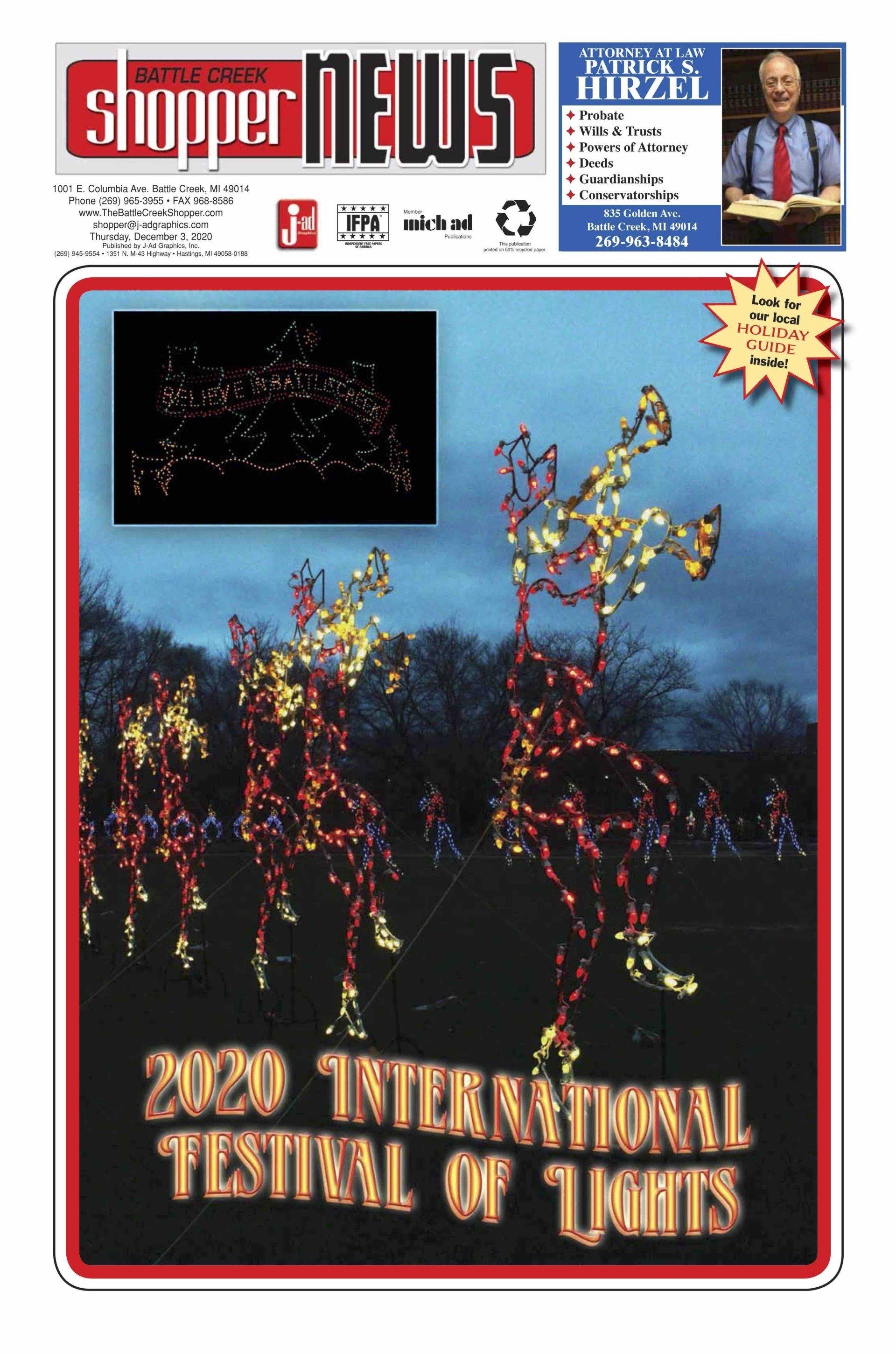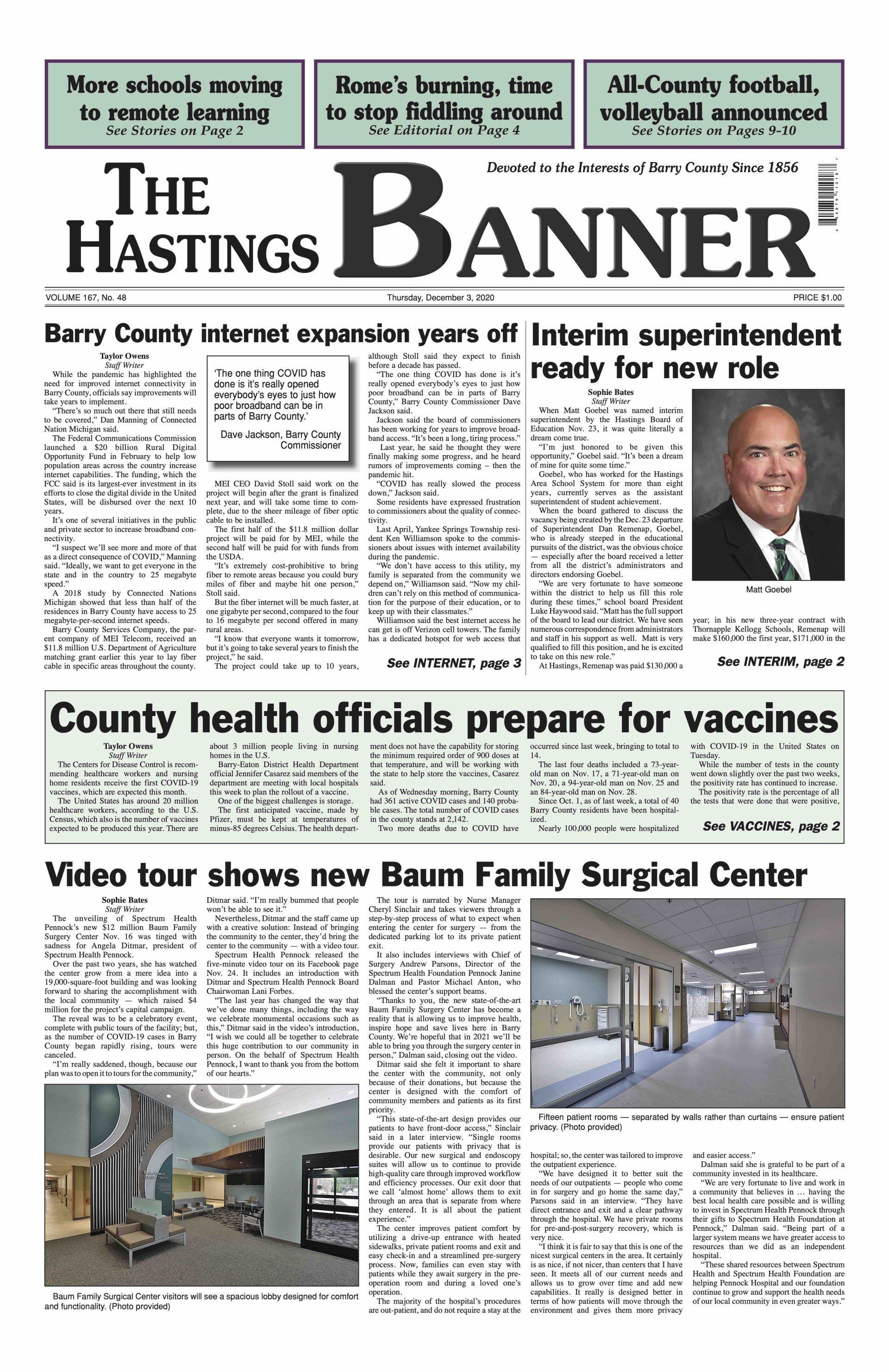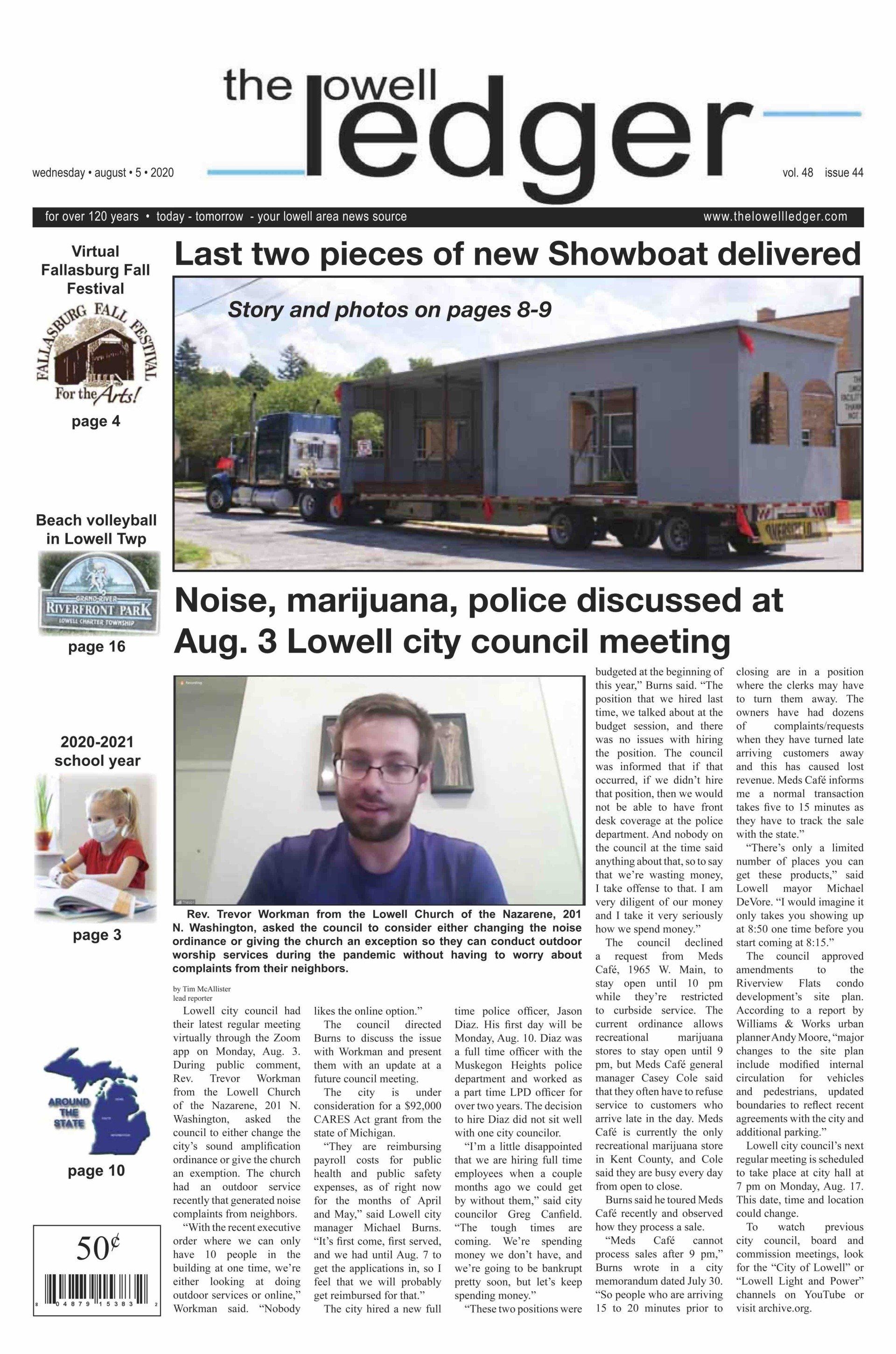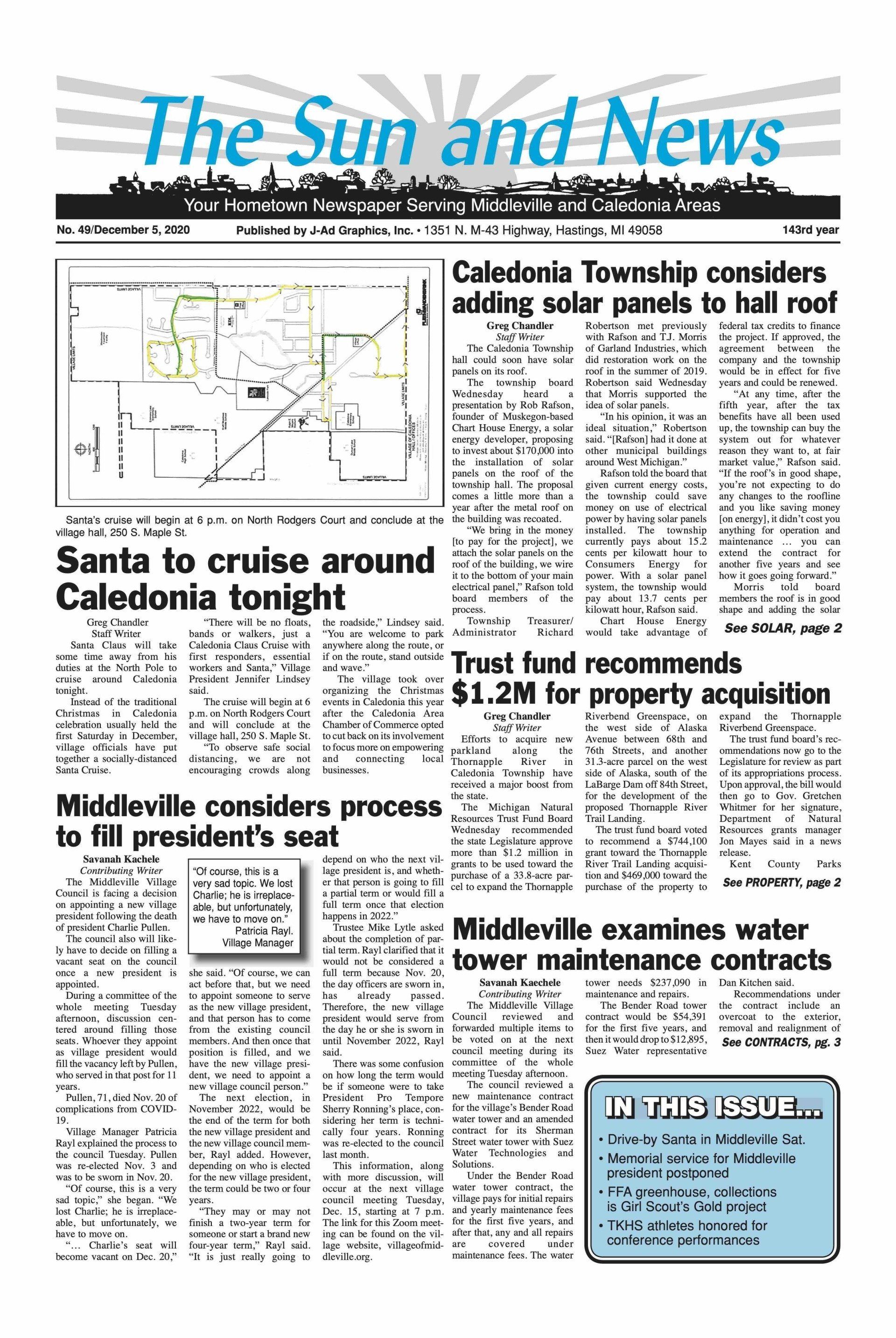World's fastest bird lives aloft in downtown Battle Creek
March 25, 2021
See banded leg in photo, below
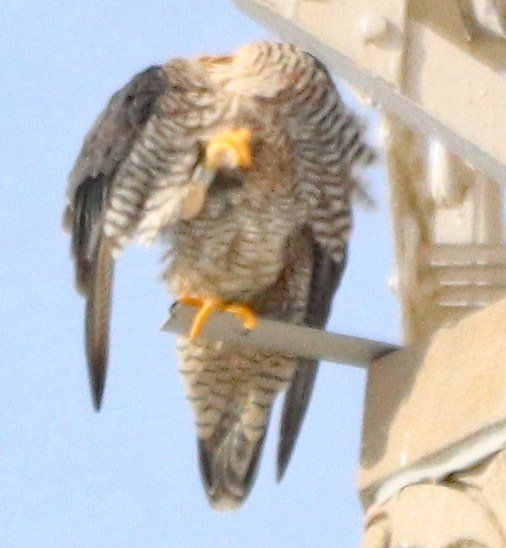
Shelly Sulser
Executive Editor
It’s the fastest bird in the world, reaching speeds up to 200 mph.
It has razor sharp talons and “hooky” beaks for ripping flesh. And, it has shared downtown Battle Creek with humans since at least 2005, littering the sidewalks with its leftovers of pigeon, duck and other feathered prey.
Battle Creek’s peregrine falcons, which mainly live atop The Milton and the Hart-Dole-Inouye Federal Center, and, on the Battle Creek Tower, have been on the radar of the Michigan DNR since 2005 and have been banded and monitored ever since.
That’s according to Game Biologist Karen Cleveland with the Michigan DNR wildlife division, whose job it is to manage the Michigan Peregrine program, keeping yearly track of where they’re living and breeding.
“I find the falcons to be one of the greatest community-building assets of downtown,” said downtown resident and independent consultant, Jill Anderson. “They are endlessly interesting to watch and people love to post about them in social media.”
Though her son hates her hobby of taking photos of the dead birds she finds in the falcon’s wake, she does it to try and identify what the falcons are eating.
“If you live or work downtown, it has almost become a dark joke,” she said. “I just think it is fascinating to have birds that we can distinguish as individuals living in a highly visible place. They aren't like a flock of pigeons, because there is just this one nest downtown, just two adults. They are the talk of the town - like a prestigious family living in the Milton - people want to know what they are up to.”
While falcons are known to migrate to the Carribean or Central America in the winter, Michigan is on their migration route from the far north of Canada.
One banded female was spotted by the Battle Creek Shopper News on Feb. 11 and again on Feb. 25 perching on The Milton, while Anderson had spotted a pair even earlier, on Dec. 8 of last year.
“Yes, we do have at least one Falcon that hangs out at our building and has for years,” said The Milton developer, Mark Harmsen of MDH Development in Grand Rapids. “We were concerned that we would scare them away during the two year construction period, particularly as we repaired the exterior of the building. But one or more of the Falcons are still at The Milton. They typically perch on ledges on the 19th floor. One of our residents has taken cool pictures of a Falcon on a ledge just outside his window. We enjoy having the falcons hang out at The Milton.”
Harmsen said there was an attempt in 2018 to provide nesting for the falcons on The Milton.
“We have cell phone tower maintenance people who have to access the roof and we were concerned about a conflict with the falcons,” he said.
Local bird of prey expert and photographer, Josh Haas, of the Battle Creek Brigham Audubon Society, provides reports on the peregrine falcons to Cleveland, he said.
“I give her my findings each year but it’s been few and far between the past couple years with all the outdoor construction on the big tower downtown,” said Haas, owner of Hawks on the Wing educational videos and photography in Hickory Corners.
Cleveland said she first heard of Battle Creek’s population 21 years ago after a local man named Scott Manly mentioned his sightings near the federal center on a birding listserv.
“He was able to get a digiscoped photo of one of the birds perched on the building,” she said via email. “I got the assistance of Ray Adams, the research programs director for the Kalamazoo Nature Center at the time (and a dedicated birder), to head over to the city now and then to see if we could narrow down
if and where the birds may have been trying to nest.”
The birds, she said, were not regularly being reported, and sighting them when
either she or Adams were in the city looking was fairly hit or miss.
“We did eventually manage to spot them in the summer of 2006 regularly hunting from the Heritage Tower,” she said.
In 2014, the Federal Center installed a nest box on their roof, but there’s been no
sign that the birds have ever used it, according to Cleveland.
“To the best of my recollection, we’ve never had anyone manage to read the bands
of any birds sighted in Battle Creek,” Cleveland said, adding that it is usually a fairly time consuming effort that happens at a nest site as birds perch or come and go. “So it’s not a big surprise it hasn’t happened yet.”
According to the Michigan Wildlife Council’s 2019 YouTube video on Peregrine falcons, banding often occurs at the nests with the help of Binder Park Zoo veterinarian, Dr. Kimberly Thompson, who monitors the health of the fledglings.
Falcons and other birds such as another Michigan falcon, the Merlin, were reduced in number prior to the 1980s when the chemical pesticide DDT built up in the bodies of many birds causing their egg shells to be thin and brittle.
DNR Communications and Education Coordinator in the video, Hannah Schauer, explained that when the birds would sit on their eggs, they would crush.
In fact, peregrine falcons had vanished east of the Mississippi by the 1960s and in 1972, The U.S. Environmental Protection Agency (EPA) canceled the authorized use of the chemical which not only harmed wildlife but posed human health risks, too.
“So we do band the peregrine falcons to keep track of their populations,” Schauer said.
Thompson examines the fledglings for parasites and other blood anomalies before they are banded and returned to their nesting parents.
“So, when we arrive,” she said in the video (Thompson could not be reached for comment), “we remove the falcons from the nest, the chicks, and we’ll perform a physical exam on the chicks, treat them for any ectoparasites (external, like fleas), look for any health problems, as well as we collect blood from the chicks and we’ll evaluate that and make sure everything looks good and healthy.”
Once any banded birds are released, there’s a limit to how much they can be monitored, depending on the species’ biology and the kind of banding or marking technology used, said Cleveland.
“Since peregrine falcons are long distance migrants which often don’t return to the area around the nest they hatched in when they’re ready to breed, many banded peregrine chicks will never be identified as adults and their sighting data recorded,” said Cleveland. “To make it a little easier for peregrines, and some other species, to be tracked, in addition to the standard federal Bird Banding Lab metal band that’s used for all banding, we use a secondary band that’s easier to read from a distance.”
The federal band is an engraved metal band that’s virtually impossible to read unless you have the bird in hand.
“The secondary band uses a combination of color and large, bright, simple letter/number codes that can be seen with binoculars or a spotting scope and sometimes with the naked eye if you’re close enough,” said Cleveland.
Both the federal band code and color band code used for each bird are registered in the US Bird Banding Laboratory database, and sightings of birds can be submitted using their online band reporting form at
http://reportband.gov/.
“For the most part, we don’t track success of individual nests or chicks fledged in Michigan, we track the overall nesting population size and nest success at fledging,” Cleveland explained. “The species is
doing well enough in the state that this provides the overall trend data we need to assess how well the species is doing.”
For birds banded in the Midwest, there’s an openly shared database of banding stored at https://midwestperegrine.umn.edu/ which includes reports on falcon populations and nesting activity in Battle Creek.
“The site also includes annual nesting summaries from the region since several states worked together to pool resources and expertise to bring the species back to the Midwest,” said Cleveland.
Although there are no falcon nest cams in Battle Creek, the DNR recently issued a press release including the links to nest cams as near at Kalamazoo and as far away as Sault Ste. Marie:
“Since the 1980s, when the DNR started a program to restore Michigan’s peregrine numbers, dedicated nest watchers have played a vital role in understanding this species.
“These tireless volunteers help us better understand the timing of peregrine falcon reproduction, breeding and chick-rearing behaviors and sources of mortality.
Up until a few years ago, this meant long hours with binoculars or a spotting scope watching an urban nest box or a remote cliffside ledge.
Today, technology makes the job a lot easier.
With multiple webcams across the state, from the northern U.P. to the Detroit suburbs, anyone can become an amateur naturalist from the comfort of home. With this convenience and close-up views, we get valuable insight into falcons' conservation needs and ways to help peregrine landlords in cities provide the best possible nesting habitat.
Want to discover this species for yourself?
Check out some of the webcams provided by our conservation partners and find answers to some of the questions they’ve helped us solve, like these:
Do all of Michigan’s peregrines start breeding at the same time? If they don’t, is there a pattern to when they start?
How long does it take a peregrine to lay all of her eggs?
How much time does a peregrine spend incubating eggs?
Do the parents share incubation, hunting and feeding duties?
How soon will a chick start growing flight feathers and losing its down?
Peregrine webcam list:
Macomb County Building
https://www.earthcam.com/usa/michigan/clinton/?cam=macomb_falcon
General Motors Tech Center in Warren
https://www.earthcam.com/usa/michigan/warren/falcon/?cam=falcon_mi
Lansing Board of Water and Light Eckert Plant
https://www.lbwl.com/falconcam?utm_campaign=news+digest+march2021+week2&utm_medium=digest&utm_source=govdelivery
Fifth Third Bank in Kalamazoo https://www.kalamazoofalcons.com/watch-falcon-cam/nest-cam
L.V. Eberhard Center in Grand Rapids
http://35.39.177.231/view/view.shtml?id=13058&imagepath=%2Fmjpg%2Fvideo.mjpg%3Fcamera%3D1&size=1&utm_campaign=news+digest+march2021+week2&utm_medium=digest&utm_source=govdelivery
Jackson County Building (Note: Not yet live for this season)
https://www.co.jackson.mi.us/787/Falcon-Report?utm_campaign=news+digest+march2021+week2&utm_medium=digest&utm_source=govdelivery
International Bridge in Sault Ste. Marie (Note: Not yet live for this season)
https://www.saultbridge.com/falcam/?utm_campaign=news+digest+march2021+week2&utm_medium=digest&utm_source=govdelivery


